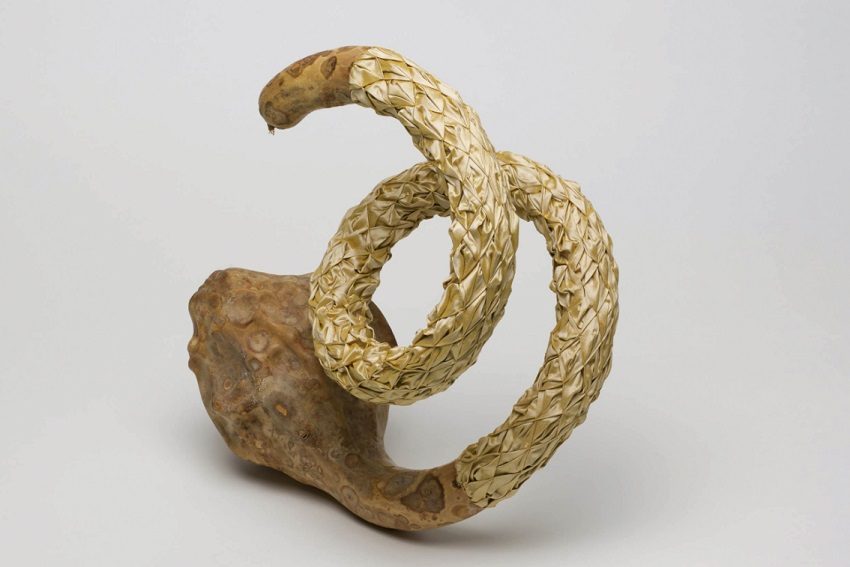Superstition and Sex in Julia Robinson's Sculptures

Julia Robinson is attracted to the twilight zone of folklore and superstition which stems from an interest in death and notions of an afterlife. Sex keeps bobbing up.
Many of her works are spooky and occasionally bawdy or wicked in a playful kind of way. But for all the references to the dark side, the occult and things that go bump in the night, it is hard to accept these sculptures as scary. So if we are not scared of them, how are we to respond?
That depends on what kind of sculpture is on offer. There is an earlier body of work inspired by old folktales and proverbs. These are not literal translations of wise-acre admonitions about new brooms sweeping cleaner and broken mirrors bringing bad luck but surreal propositions that resemble the night sweat terrors of familiar objects and situations becoming terrifying.
 Julia Robinson, A Sunny Pleasure Dome (2016), copper plated gourd, silk, thread, ribbon, stainless steel, 65 x 35 x 25cm. Courtesy the artist and GAGPROJECTS, Adelaide
Julia Robinson, A Sunny Pleasure Dome (2016), copper plated gourd, silk, thread, ribbon, stainless steel, 65 x 35 x 25cm. Courtesy the artist and GAGPROJECTS, Adelaide
From the outset, and despite the intense research the artist has invested in the occult, mysticism, black magic, superstition and folklore, there has been a disciplined distancing from source material. From any perspective, artwork inspired by old rituals and folk traditions should have no claim on our feelings beyond amusement and the odd feeling that sometimes time-honoured truths, or proverbs, such as old brooms knowing where the corners are can have some contemporary resonance. And after all, who would want to revisit a world of magic powers and irrational prejudices in which, for example, a man would walk a mile rather than between two old women on the road, or never, if a girl, fight with a broom because that determined that you would die an old maid.
However, Robinson’s edgier sculptures, like a set of hands reaching out from a bedstead, and a fireplace that looks like a portal to the underworld, tap into deeper subconscious anxieties about things spiralling out of control. The ‘goat series’ – featuring various goats made from soft fabrics – quietly shoe-horn the artist and her viewing public into deeper, darker waters.
 Julia Robinson, The fruit that made man wise (2016). Courtesy the artist and GAGPROJECTS, Adelaide. Photograph: Sam Roberts.
Julia Robinson, The fruit that made man wise (2016). Courtesy the artist and GAGPROJECTS, Adelaide. Photograph: Sam Roberts.
This creature with its satanic credentials hard-wired to centuries of folk belief and prejudice, is the basis of a grotesque catalogue of attitudes and scenarios inviting the kind of amusement associated with bear-baiting or tuna-tossing. By the time these creatures get around to making the beast with two backs (see Othello, Act 1, Scene 1) costuming gets involved which conceals everything but the nether regions.
Again, are we still worried that the Templars’ (see Dan Brown, The Da Vinci Code) contemporary equivalents worship Baphomet, the great goat headed deity with pentagram on forehead? Unlikely, but you should be curious about a possible connection with Robert Rauschenberg’s late 1950s combine Monogram (the sculpture dominated by a goat wearing a car tire), which Robert Hughes reminded, honours a creature whose lust, according to William Blake, is the glory of God. Robinson’s goats, rutting with priapic energy, are an entry point into deeper levels of a creative imagination that believes in art’s social agency. While we no longer believe that leaving a broom with a person will ward off evil spirits, it might be possible to imagine that an artwork can be a talisman or amulet, a source of positive affirmation in troubled times.
 Julia Robinson, Early riser (2016), gourd, silk, thread, copper, copper plated eyelets, fixings, stainless steel, 95 x 80 x 28cm. Courtesy the artist and GAGPROJECTS, Adelaide.
Julia Robinson, Early riser (2016), gourd, silk, thread, copper, copper plated eyelets, fixings, stainless steel, 95 x 80 x 28cm. Courtesy the artist and GAGPROJECTS, Adelaide.
So where does this leave Robinson’s most recent body of work as encapsulated in The Song of Master John Goodfellow series? Goodbye goat (for now) and welcome the gourd.
The gourd is the scene grabber in a cornucopia of wondrous forms that look like props from a commedia dell’arte production. The gourd back story is one for another day but includes the enduring presence of fruit and vegetables as ready-made sex symbols in a tradition that can be traced from Raphael and Caravaggio to the modern era. To the comical and grotesque character of the gourd Robinson has added dashes of luxe in the form of delicately pleated collars, smock stitched chiffon, silk appendages and costuming. This risible association of wizened, scrotum-like vessels with silky-splendour prophylactic appendages snaking and coiling like an old man’s imagination are excellent examples of how the artist feeds her imagination on historical sources (particularly Rabelaisian irreverence) but retains the right and ability to invent forms that suit her own purpose.
Julia Robinson, Long Ballads
An ACE Open interstate presentation
Presented in partnership with Artspace, Artspace Ideas Platform, Woolloomooloo, Sydney
Until Friday, July 14
aceopen.art
Header image: Julia Robinson, Tucked Bend, gourd, silk, thread, mixed media, 40 x 40 x 25cm, 2017, Courtesy the artist and GAGPROJECTS, Adelaide
Photography: Sam Roberts